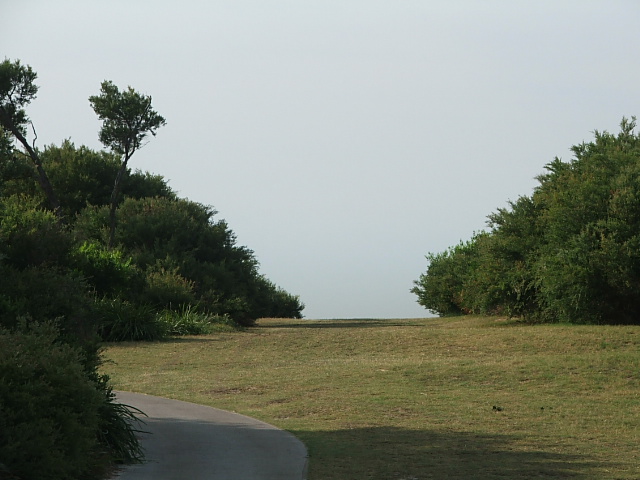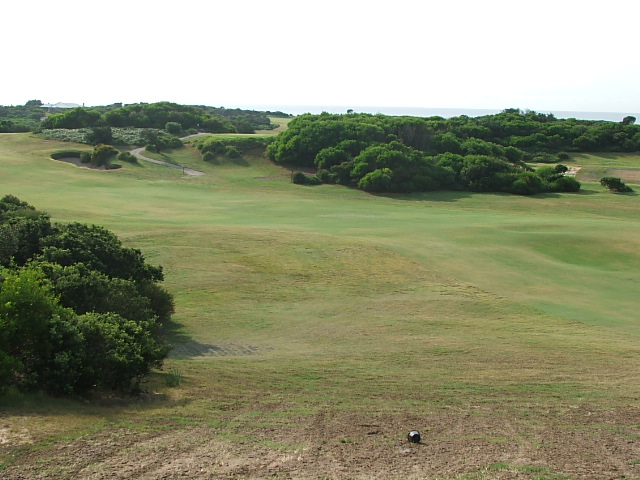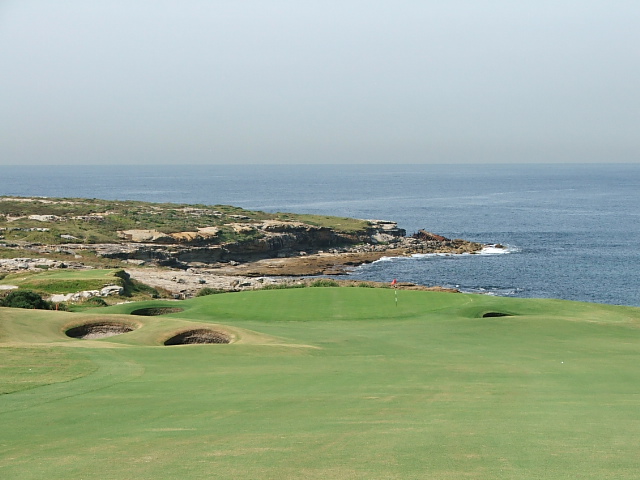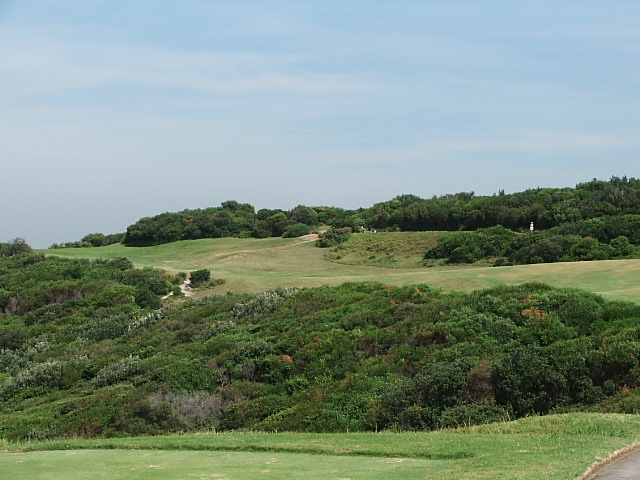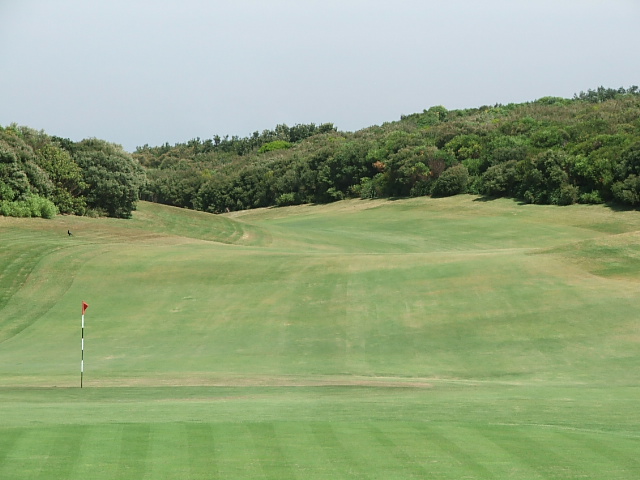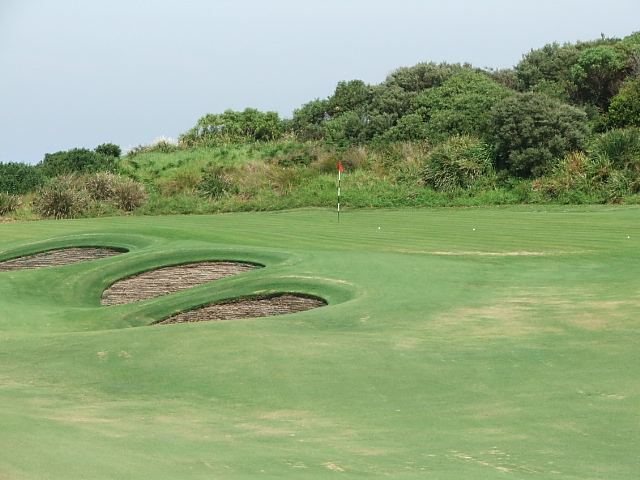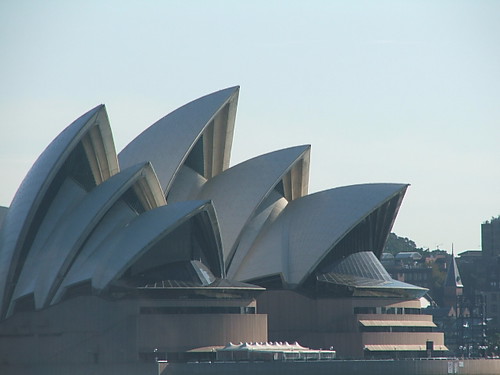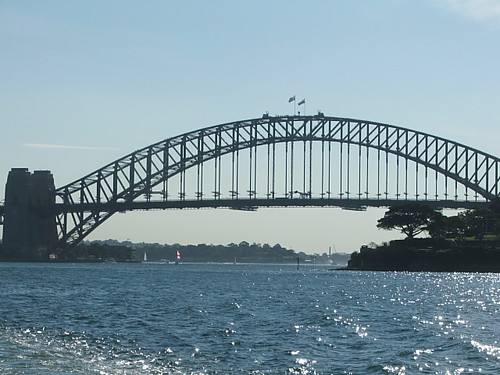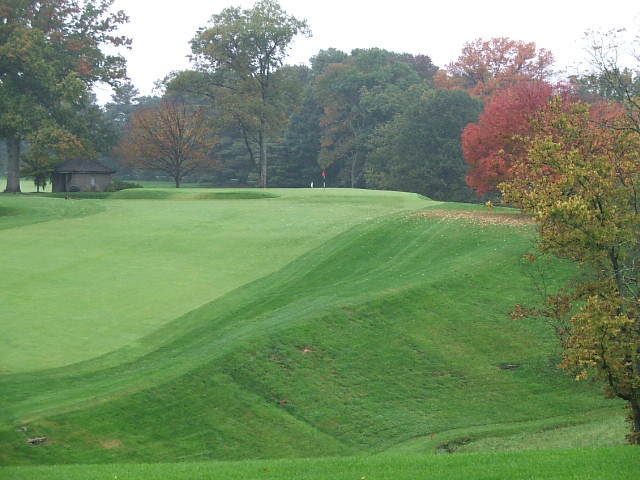
In the log book of H.M.S. Endeavour, commanded by Captain Cook, the entry for April 29 1770 reads "Anchored at 3 p.m. in a place which I called Sting Ray Harbour." The ‘place’ is the current location of the New South Wales Golf Club (ranked #43 in the world) located in La Perouse, just south of Sydney. The bay was subsequently renamed Botany Bay, and it was here that the current history of Australia began. As I am always cautious to be politically correct, obviously, the indigenous aboriginal people were already on the continent. It’s interesting to think that Australia hadn't even been settled by westerners yet, while some thirty years before, in 1744, the Honourable Company of Edinburgh Golfers was established in Scotland.
You can see the white New South Wales clubhouse perched on top of the hill to the right, in the middle distance, when you land at Sydney Airport. Planes headed towards its parallel runways are visible throughout your round.
Alister MacKenzie produced the initial routing map for New South Wales, but real credit for the design is largely given to Eric Apperly, who completed the work. Apperly also made changes to several holes over time, including designing the most famous hole on the course, the par three sixth. From 1942-1946 the land and clubhouse were surrendered to the armed services, and the course was rebuilt after the war under his supervision.
New South Wales is a links-style course that has a great routing, plays fast and firm and has a fair number of blind shots. The course has two distinct personalities to it. Holes three through six are characterized by great use of the hilly terrain and dramatic views. The stunning water holes like the fifth and sixth have a feel similar to the Monterey Peninsula and are inspiring. The inland holes on the back nine, particularly the severe doglegs, have a completely different feel and play inland, away from the headlands. My favorite stretch of the course was not the renowned water holes, but the inland stretch from thirteen through sixteen. The interesting combination of heavy vegetation, dunes and blind shots was at times reminiscent of Royal County Down to me.
 Bunkering on the first hole
Bunkering on the first hole The blind fifth hole tee shot at New South Wales
The blind fifth hole tee shot at New South Wales The carry to the top of the ridge is about 240 meters, but if you can pull it off, you’ll have only 100 meters to go to the green. The cliffside green is situated at the bottom of the dramatic hill with the water behind it. If you don’t carry the ridge, you’ll have another blind shot over the top, down the hill. Walking over the ridge and seeing the breathtaking view of the bay below is one of the great vistas in the game of golf.
The 5th green near the water
The sixth hole is the famous cross-ocean hole similar to Cypress Point’s sixteenth hole, although I don’t think any hole in the world truly compares to Cypress’s sixteenth. The 500 Toughest Golf Holes in the World ranks the sixth among its holes and I concur. It is 185 meters and uphill from the back tee and all carry. I hit a driver from the far back tee and made a par on the hole, the highlight of my day.
The 500 Toughest Holes book’s characterization of these back-to-back holes is right on: “In the same way that Pebble Beach’s par five sixth offers a worthy prelude to the par three seventh, the fifth hole is a prologue to the beloved par three sixth.”
The iconic par three 6th at New South Wales
The fourteenth hole is one that I enjoyed very much. Beware of short par fours. This 323 meter gem is not an easy hole. Tom Doak describes the fairway as “roller-coaster” and it is indeed. Like many of the world’s greatest, it is a classic risk-reward hole. You have to hit over a huge scrub-filled chasm to a dogleg left fairway that largely slopes back toward you, right to left. The best play is further right, leaving you a greater distance from the flag, however, at least your ball stays where you hit it. Trying to cut off too much of the dogleg and playing toward the flag to the left is not a smart play, primarily because the slope of the fairway will shoot your ball way left down the imposing hill. Normally, the safer route allows the less skilled player a fair shot of hitting the fairway. The fourteenth is especially tricky in this regard. Although it is a shorter carry off the tee, if you carry too far right it runs through the fairway and your ball is lost. It is like hitting a putt, where you need precision in both line and distance, but on your tee shot! Planet Golf calls the second shot at fourteen one of the best pitch shots in the world to its exposed skyline green.
The difficult to hit 14th fairway over chasm
The seventh and fourteenth holes have a similar feel of playing at Kawana in Japan with holes routed through lush vegetation along dramatic high headlands. In particular, the fourteenth hole at New South Wales reminded me of the classic fifteenth at Kawana, requiring a demanding tee shot over a chasm to a difficult to hit, harshly sloping fairway.
New South Wales is at its best on its many severe dogleg holes. The most testing of these are the fifteenth and sixteenth. Fifteen is a 372 meter sharp dogleg right that demands an exacting drive up a hill into a narrow landing area. With the prevailing wind, it is quite unlikely that you can hit it far enough to see around the corner of the dogleg to the difficult green. This hole has the highest average in relation to par on the Australasian tour. The narrow, uphill, tight, difficult to hit 15th fairway, from the tee:

It is one of the hardest holes I have ever played, first, because the landing area off the tee is so small and, second, because you have to hit a LONG blind second shot to a tough green.
The 15th fairway looking back from the green
Sixteen is a difficult 403 meter sharp dogleg to the left that requires a precise shot off the tee to have a chance at hitting the well-bunkered green. Note the nice sod faced difficult bunkers on sixteen. Adam Scott ranks this hole as one of the top three holes in Australia, along with the third hole here.
The 16th green
The course is difficult to pin down into one style and to compare to other courses. While playing some of the inland holes on the back nine, which are surrounded by bottle-brush (similar to gorse), the course reminded me a bit of Durban in South Africa and had a real feel of playing through the bush.
The club doesn’t own the land the course is on; instead, it leases it from the government, since it is set within a national park, making it a nicely isolated piece of property.
There are not many courses in the world that can be compared to such a diverse group of courses such as Cypress Point, Durban, Royal County Down and Kawana. The eclectic feel of the various parts of the course really makes New South Wales a microcosm of many of the greatest courses in the world. It was also the most difficult of all the courses we played in Australia.
Many thanks to my gracious host Michael Taylor, a golf-crazed student of the game. I didn’t experience the full impact of New South Wales while visiting, as the greens were punched and the wind wasn’t blowing. Thus, I hope to return someday to play the course and experience the greens in top form. Also, I would like to prove to him that my game isn’t really as bad as it looked the day we played. In what was clearly an appropriate gesture, the black and white Magpies and their distinctive ‘laugh,’ had a riotously funny day mocking me.

Magpie at New South Wales
Sydney, Australia

I visited Sydney once before, about fifteen years ago, and was very much impressed with it. The iconic Opera House is quite a spectacle, and Sydney Harbour is one of the natural wonders of the world. The water is so clear you can just about see to the bottom of it.
It was nice to be back in this great city. One of the things I like to do when traveling is to get up early in the morning and go for a walk while the world is still asleep. One of my best memories on this quest is waking very early and going for a walk around Campbeltown, Scotland as the sun rose on the day I played Macrahanish. Aided by jet leg and an adrenaline rush, I awoke at 4:00 am in Sydney and went for a walk in the old part of town.

The collection of buildings around Hyde Park are pretty cool. The old Sydney Hospital, the Mint building, the New South Wales Supreme Court, the Hyde Park Barracks and St. Mary's Cathedral are an impressive bunch. The old bank buildings in the financial district remind me of similar buildings in San Francisco, built during each's gold rush; they were built to last and to convey strength.

Sydney combines the best of the world's greatest cities into an experience that doesn't overwhelm. It takes the best of what many world-class cities have and improves on them just a bit. Aside from a feel of San Francisco in its gold rush years, it has New York's buzz and traffic (but is cleaner), and L.A.'s weather (but no earthquakes). Like many European cities it is easily walkable, has good museums and proper coffee. Of course it also has a major British touch: they drive on the wrong side of the road, talk funny and there are statues of Queen Victoria all over.
Most Americans' image of an Australian has unfortunately been set by advertising for Outback Steakhouse and Paul Hogan's image of Crocodile Dundee. There didn't appear to me to be many people "who throw another shrimp on the barbie," and we didn't see one person drinking Foster's the entire time in the country.
